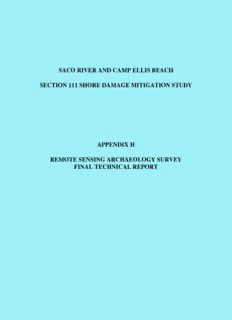
Appendix H: Archaeology PDF
Preview Appendix H: Archaeology
SACO RIVER AND CAMP ELLIS BEACH SECTION 111 SHORE DAMAGE MITIGATION STUDY APPENDIX H REMOTE SENSING ARCHAEOLOGY SURVEY FINAL TECHNICAL REPORT FINAL TECHNICAL REPORT REMOTE SENSING ARCHAEOLOGICAL SURVEY Camp Ellis Beach Saco, Maine Contract No. W912WJ-09-D-0001-0019 Prepared For: United States Army Corps of Engineers New England District 696 Virginia Road Concord, MA 01742 Prepared By: Fathom Research, LLC 1213 Purchase Street, Ste 315 New Bedford, MA 02740 For: Woods Hole Group, Inc. 81 Technology Park Drive East Falmouth, MA 02536 And: The Public Archaeology Laboratory, Inc. 210 Lonsdale Avenue Pawtucket, RI 02860 July 2010 This page intentionally left blank FINAL TECHNICAL REPORT REMOTE SENSING ARCHAEOLOGICAL SURVEY CAMP ELLIS BEACH Saco, Maine Prepared by: David S. Robinson, M.A., R.P.A. Principal Investigator Fathom Research, LLC 1213 Purchase Street, Suite 315 New Bedford, Massachusetts 02740 Submitted to: The Public Archaeology Laboratory, Inc. 210 Lonsdale Avenue Pawtucket, Rhode Island 02860 Woods Hole Group, Inc. 81 Technology Park Drive East Falmouth, Massachusetts 02536 Prepared for: U.S. Army Corps of Engineers, New England District 696 Virginia Road Concord, Massachusetts 01742-2751 May 2010 MANAGEMENT ABSTRACT A systematic remote sensing archaeological survey was performed in November 2009 for the U.S. Army Corps of Engineers, New England District’s proposed nearshore breakwaters and jetty-spur project study area at Camp Ellis Beach, Saco, in York County, Maine. The investigation involved archival research, field survey to record marine geophysical and geotechnical data, and analysis and synthesis of the research and survey results to assess the Project study area’s archaeological sensitivity and to determine the presence/absence of prehistoric and historic period submerged archaeological deposits within it. The survey was authorized and conducted under contract with the U.S. Army Corps of Engineers, New England District to comply with Section 106 of the National Historic Preservation Act of 1966 as amended (1976, 1980, 1992, 1999) (36 CFR 800). Performance of the remote sensing archaeological reconnaissance survey resulted in the conclusions that Project study area: possesses a low archaeological sensitivity for containing contextually intact formerly terrestrial and/or maritime-related submerged prehistoric archaeological deposits and a moderate archaeological sensitivity for containing submerged historic archaeological deposits, although contains no previously identified National Register-eligible or listed prehistoric or historic archaeological properties; contains no remote sensingl or geotechnical evidence of contextually intact paleosols with prehistoric archaeological sensitivity and: contains no remote sensing evidence of submerged historic period shipwrecks or maritime infrastructure. Based on the results of this study, no further archaeological investigation of the offshore portion of the proposed Camp Ellis Beach nearshore breakwaters and jetty-spur project area is recommended. H-i TABLE OF CONTENTS 1 INTRODUCTION....................................................................................................................................6 Scope.........................................................................................................................................................6 Authority...................................................................................................................................................6 Project Description....................................................................................................................................7 Nature of Study.........................................................................................................................................7 Project Personnel.......................................................................................................................................7 Disposition of Project Materials...............................................................................................................8 2 METHODOLOGY..................................................................................................................................9 3 ENVIRONMENTAL CONTEXT........................................................................................................14 Bedrock Geology....................................................................................................................................15 Surficial Geology....................................................................................................................................15 Marine Transgression and Site Preservation...........................................................................................17 Post-Glacial Environmental Conditions and Human Settlement Patterns..............................................18 4 CULTURAL CONTEXT......................................................................................................................20 Prehistoric Period Culture History..........................................................................................................20 Paleoindian Period (11,500-9500 B.P.)..............................................................................................20 Archaic Period (9500-3000 B.P.)........................................................................................................22 Ceramic Period (3000-450 B.P.).........................................................................................................27 Historic Period Culture History..............................................................................................................28 5 RESULTS AND RECOMMENDATIONS..........................................................................................36 Archival Research Results......................................................................................................................36 Prehistoric Archaeological Sensitivity................................................................................................36 Historic Archaeological Sensitivity....................................................................................................36 Archaeological Field Survey Results......................................................................................................37 Geotechnical Data Review Results.........................................................................................................37 Recommendations...................................................................................................................................38 BIBLIOGRAPHY.....................................................................................................................................39 FIGURES APPENDICES A PROJECT SCOPE-OF-WORK B CRE SURVEY REPORT C INVENTORY OF SIDE-SCAN SONAR ANOMALIES D INVENTORY OF MAGNETIC ANOMALIES E GEI GEOTECHNICAL BORINGS DATA H-ii LIST OF TABLES Table 2-1. Camp Ellis Beach Survey Area Corner Point Coordinates...............................................10 Table 4-1. Maine’s Comprehensive Planning Prehistoric Period Archaeology Study Units.............21 H-iii LIST OF FIGURES Figure 1-1. General location of the Camp Ellis Beach project area within the State of Maine (source: Fathom 2010). Figure 3-1. Excerpt of USGS quadrangle map showing Camp Ellis Beach project survey area location at the mouth of the Saco River, Saco, Maine (source: Fathom 2010). Figure 3-2. Approximate limit of the marine invasion of land following the recession of the Wisconsin glaciations (source: Kendall 1996:33). Figure 3-3. Relative sea-level curve for the coast of Maine for the last 14,000 years (source: Crock et al. 1993). Figure 4-1. Samuel de Champlain’s 1605 map showing a Native American settlement at the mouth of the Saco River, Saco, Maine (source: Bourque 2001:116). Figure 4-2. Map of native tribal territories and European trading posts and settlements 1620-1676 (source: Bourque 2001:130). Figure 4-3. Map of the original landholdings of the Saco settlement along the east bank of the Saco River during the early eighteenth century (source: Owen 1891). Figure 5-1. Bathymetric contours (0.5 ft contour interval) as recorded within the Camp Ellis Beach project survey area (source: CRE 2009). Figure 5-2. Side-scan sonar mosaic with inventoried side-scan sonar anomalies and NAE’s proposed breakwater and jetty-spur structures (source: CRE 2009). Figure 5-3. Sunken modern geotechnical boring drill-barge and displaced drill bits within the Camp Ellis Beach project survey area (source: NAE 2009). Figure 5-4. Ambient magnetic field strength, survey vessel track lines, side-scan sonar and magnetometer anomaly locations and the NAE’s proposed breakwater and jetty-spur structures (source: CRE 2009). Figure 5-5. Contoured acoustic basement depths (2 ft contour interval) as recorded along sub-bottom profile transects “A” and “B” where substantial acoustic penetration was achieved with the 10 kHz sub-bottom profiler (source: CRE 2009). Figure 5-6. Representative examples of 10 kHz sub-bottom profiles recorded in the Camp Ellis Beach project survey area (source: CRE 2009). H-iv
Description: